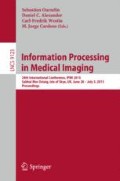Abstract
In this paper we demonstrate a simulation framework that enables the direct and quantitative comparison of post-processing methods for diffusion weighted magnetic resonance (DW-MR) images. DW-MR datasets are employed in a range of techniques that enable estimates of local microstructure and global connectivity in the brain. These techniques require full alignment of images across the dataset, but this is rarely the case. Artefacts such as eddy-current (EC) distortion and motion lead to misalignment between images, which compromise the quality of the microstructural measures obtained from them. Numerous methods and software packages exist to correct these artefacts, some of which have become de-facto standards, but none have been subject to rigorous validation. The ultimate aim of these techniques is improved image alignment, yet in the literature this is assessed using either qualitative visual measures or quantitative surrogate metrics. Here we introduce a simulation framework that allows for the direct, quantitative assessment of techniques, enabling objective comparisons of existing and future methods. DW-MR datasets are generated using a process that is based on the physics of MRI acquisition, which allows for the salient features of the images and their artefacts to be reproduced. We demonstrate the application of this framework by testing one of the most commonly used methods for EC correction, registration of DWIs to b = 0, and reveal the systematic bias this introduces into corrected datasets.
Access this chapter
Tax calculation will be finalised at checkout
Purchases are for personal use only
References
Zhang, H., Schneider, T., Wheeler-Kingshott, C.A., Alexander, D.C.: NODDI: practical in vivo neurite orientation dispersion and density imaging of the human brain. NeuroImage 61(4), 1000–1016 (2012)
Tournier, J., Calamante, F., Gadian, D.G., Connelly, A., et al.: Direct estimation of the fiber orientation density function from diffusion-weighted MRI data using spherical deconvolution. NeuroImage 23(3), 1176–1185 (2004)
Le Bihan, D., Poupon, C., Amadon, A., Lethimonnier, F.: Artifacts and pitfalls in diffusion MRI. J. Magn. Reson. Imaging 24(3), 478–488 (2006)
Oguz, I., Farzinfar, M., Matsui, F., Budin, F., Liu, Z., Gerig, G., Johnson, H.J., Styner, M.: DTIPrep: quality control of diffusion-weighted images. Front. neuroinformatics. 8, 1–11 (2014)
Jenkinson, M., Smith, S.: A global optimisation method for robust affine registration of brain images. Med. Image Anal. 5(2), 143–156 (2001)
Andersson, J.L.R., Skare, S., Ashburner, J.: How to correct susceptibility distortions in spin-echo echo-planar images: application to diffusion tensor imaging. Neuroimage 20(2), 870–888 (2003)
Mangin, J.-F., Poupon, C., Clark, C., Le Bihan, D., Bloch, I.: Distortion correction and robust tensor estimation for MR diffusion imaging. Med. Image Anal. 6(3), 191–198 (2002)
Zhuang, J., LU, Z.-L., Vidal, C.B., Damasio, H.: Correction of eddy current distortions in high angular resolution diffusion imaging. J. Magn. Reson. Imaging 37(6), 1460–1467 (2013)
Jezzard, P., Barnett, A.S., Pierpaoli, C.: Characterization of and correction for eddy current artifacts in echo planar diffusion imaging. Magn. Reson. Med. 39(5), 801–812 (1998)
Kwan, R.K.-S., Evans, A.C., Pike, G.B.: MRI simulation-based evaluation of image-processing and classification methods. IEEE Trans. Med. Imaging 18(11), 1085–1097 (1999)
Drobnjak, I., Gavaghan, D., Süli, E., Pitt-Francis, J., Jenkinson, M.: Development of a functional magnetic resonance imaging simulator for modeling realistic rigid-body motion artifacts. Magn. Reson. Med. 56(2), 364–380 (2006)
Neher, P.F., Laun, F.B., Stieltjes, B., Maier-Hein, K.H.: Fiberfox: Facilitating the creation of realistic white matter software phantoms. Magn. Reson. Med. 72(5), 1460–1470 (2013)
Bastin, M.E.: Correction of eddy current induced artefacts in MR diffusion iterative cross-correlation. Magn. Reson. Imaging 17(7), 1011–1024 (1998)
Nunes, R.G., Drobnjak, I., Clare, S., Jezzard, P., Jenkinson, M.: Performance of single spin-echo and doubly refocused diffusion-weighted sequences in the presence of eddy current fields with multiple components. Magn. Reson. Imaging 29(5), 659–667 (2011)
Van Essen, D.C., Ugurbil, K., et al.: The human connectome project: a data acquisition perspective. Neuroimage 62(4), 2222–2231 (2012)
Zhang, Y., Brady, M., Smith, S.: Segmentation of brain MR images through a hidden markov random field model and the expectation-maximization algorithm. IEEE Trans. Med. Imaging 20(1), 45–57 (2001)
Basser, P.J., Mattiello, J., LeBihan, D.: Estimation of the effective self-diffusion tensor from the NMR spin echo. J. Magn. Reson. Imaging 103, 247–254 (1994)
Drobnjak, I., Pell, G.S., Jenkinson, M.: Simulating the effects of time-varying magnetic fields with a realistic simulated scanner. Magn. Reson. Imaging 28(7), 1014–1021 (2010)
Acknowledgements
MG is supported by the EPSRC (EP/L504889/1). MG and HZ are supported by the Royal Society International Exchange Scheme with China. HZ is additionally supported by the EPSRC (EP/L022680/1) and the MRC (MR/L011530/1). ID is supported by the Leverhulme Trust.
Author information
Authors and Affiliations
Corresponding author
Editor information
Editors and Affiliations
Rights and permissions
Copyright information
© 2015 Springer International Publishing Switzerland
About this paper
Cite this paper
Graham, M.S., Drobnjak, I., Zhang, H. (2015). A Simulation Framework for Quantitative Validation of Artefact Correction in Diffusion MRI. In: Ourselin, S., Alexander, D., Westin, CF., Cardoso, M. (eds) Information Processing in Medical Imaging. IPMI 2015. Lecture Notes in Computer Science(), vol 9123. Springer, Cham. https://doi.org/10.1007/978-3-319-19992-4_50
Download citation
DOI: https://doi.org/10.1007/978-3-319-19992-4_50
Published:
Publisher Name: Springer, Cham
Print ISBN: 978-3-319-19991-7
Online ISBN: 978-3-319-19992-4
eBook Packages: Computer ScienceComputer Science (R0)

